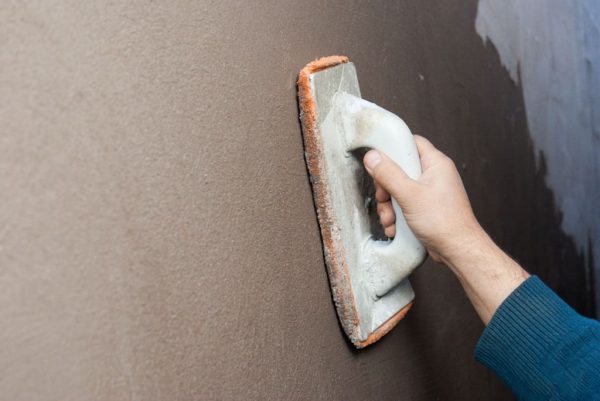When performing finishing work, plastering of surfaces is of the utmost importance. The appearance of the apartment will completely depend on the quality of the plastering events. To make the walls smooth, even, 100% ready for decorative decoration, you will need a grater for plaster. This tool is used by professionals to get the perfect result.
- What is plaster grater
- Principle of operation
- Varieties of tools
- Polyurethane
- Wooden
- Foam
- Metal
- Plastic
- Sponge graters and graters
- Grater or grater: what is the difference
- Better to use
- Advantages and disadvantages of various stucco graters
- Tool selection
- Features of the use of graters and half-graters
- Top manufacturers
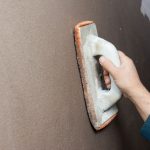
What is plaster grater
For the primary alignment of the plaster layer, a rule is used - this device creates the direction of the leveling plane. After the rule, grater and trowels are used - tools for mashing, smoothing the plaster, removing flaws and eliminating excess mortar. Grater helps to obtain a smooth coating, therefore, it is widely used for finishing walls.
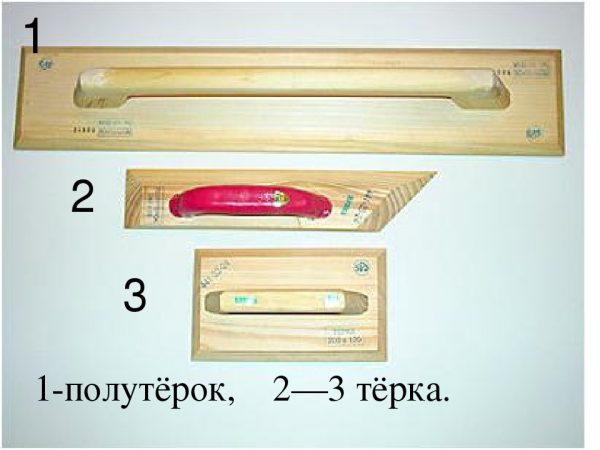
Until recently, craftsmen themselves made tools from wooden blocks with a flat surface, to which they attached a handle. Such improvised graters did not last long, since the wood quickly absorbs moisture, cracking when the temperature changes. Modern tools are made from more durable materials, although wooden copies are also on sale.
High-quality products allow grouting and grinding and have a lot of advantages:
- even with prolonged use, the master does not experience inconvenience, since the design of the tools is optimal for work, and the weight is quite small;
- materials of execution of graters for the most part are not afraid of moisture;
- the cost of plaster fixtures is available, they are sold in any hardware store;
- grinding tools serve for a long time: with proper use, one grater is able to process up to 1000 square meters. m area;
- the product range is large, you can choose the product of the desired shape, size, weight, with the necessary characteristics.
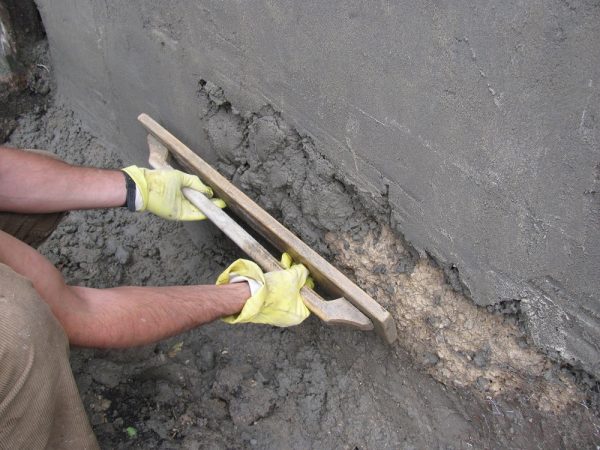
A feature of building graters is their ability to create both smooth surfaces and form a texture when it comes to decorative plaster. On sale there are even special tools with a textured surface that allow you to "draw" interesting pictures, patterns on the wall. Typically, the length of the tool platform is 12–36 cm, width is 12–18 cm, and thickness is no more than 2.5 cm. The handle can be open and closed, attached to the sole or cast with it.
to contents ↑Principle of operation
The tool acts mechanically: the sole polishes the roughness of the plaster layer, smooths it, makes it even and smooth, or gives other decorative properties. The procedure for using construction equipment is as follows:
- A small amount of the solution is kneaded in the container - it should be enough for the area, which can be processed in one go.Plaster (covering) is applied to the wall, leveled by the rule.
- The construction grater is pressed to the surface. The wet solution is rubbed in a circular motion, and counterclockwise. You need to work quickly so that the plaster does not have time to completely dry.
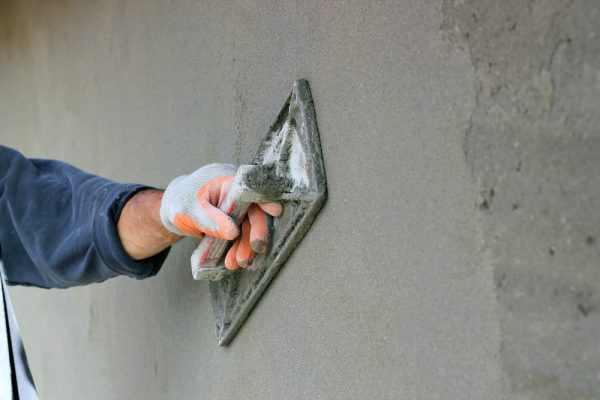
The grater is also used to grout the plaster when it is already dry. Mashing is the final stage of plastering, during which the wall will become smooth. In this case, the movements are performed not in a circle, but up and down. After processing one strip, they move to another section.
To obtain an excellent result, it is important to use only a properly mixed solution. For finishing work, plaster with finely dispersed fillers is suitable. Larger fractions can not be wiped to smoothness, except for the subsequent laying of tiles.

Varieties of tools
The main difference between all graters is the material from which they are made. Outwardly, they are all alike, and the principle of operation of the instruments is the same. The most popular are graters made of polyurethane, wood, polystyrene, metal, plastic and sponges.
Polyurethane
Construction devices made of polyurethane are now considered to be very popular. They are suitable for applying and grinding gypsum, lime and decorative plasters. The thickness of polyurethane graters reaches 3–25 mm, the “size range” is as follows:
- 120 x 240 mm;
- 110 x 600 mm;
- 140 x 280 mm;
- 180 x 320 mm.
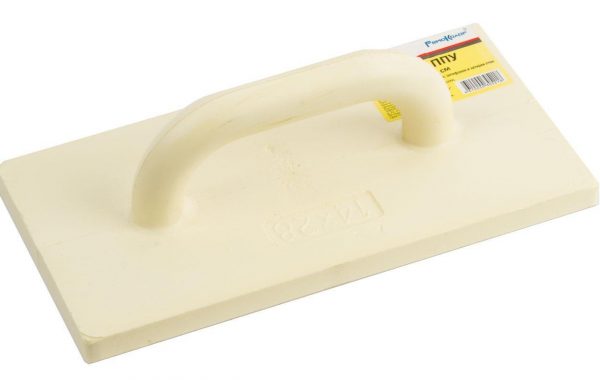
The thinnest soles (3-5 mm) of an oblong shape are suitable for working with decorative plaster, thicker ones are suitable for mashing and leveling a regular mortar. Products last a long time, comfortable, lightweight, have an ergonomic design.
Polyurethane as a hetero-chain polymer is very strong, flexible, and the most wear-resistant modifications of the material are used to make building graters.
Features of the use of tools:
- when working with decorative compositions, either the surface or the tool itself is necessarily wetted with water;
- during the work, the grater must be regularly cleaned, otherwise the quality of the finish may decrease;
- regular plastering is carried out only on a fresh layer that has not yet dried;
- for calcareous solutions, it is worth choosing only rectangular tools 20–25 cm thick.

Wooden
Wood products are considered the simplest, even quite primitive, so because of the availability of other options are rarely used. They strongly absorb moisture during operation, because any plaster mortar contains water, and the wall is wetted during mashing. The service life of wood graters is small, they gradually deform and increase weight, as a result, the complexity of mashing the plaster for the master increases greatly.
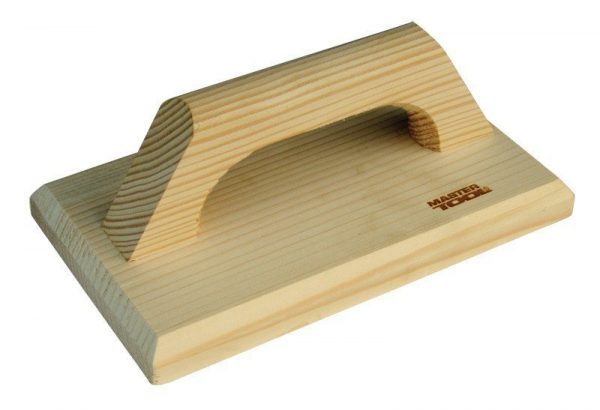
Foam
They are the most inexpensive option for building graters, but are not suitable for all types of work. For their production, fairly solid types of foam are selected that perfectly smooth and smooth the plaster. Such a tool is not suitable for creating a relief, but gypsum and polymer plasters after processing will find a perfectly smooth surface. It is necessary to handle the foam tool carefully, because it is quite fragile and can break.
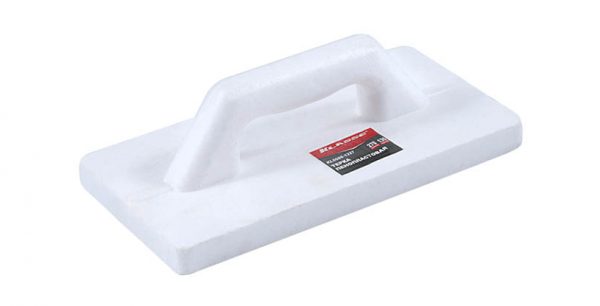
Metal
Most often, metal building graters are used for ironing walls. During ironing, a thin water-repellent film is formed on the coating, which will protect the plaster from the negative effects of moisture. Smooth metal tools make the surface smooth, almost glossy. With the help of such graters, even a porous solution can be compacted, which other tools cannot handle.
To grind coarse plaster, metal graters with a coarse grinding surface can be used. They are especially suitable if special buckets were used to distribute the plaster. Next, the finish layer is treated with a grater with a smooth sole, using a circular grout or up and down movements. On sale there are also metal tools with a gear base. They are used for leveling adhesive compositions under ceramic tiles.
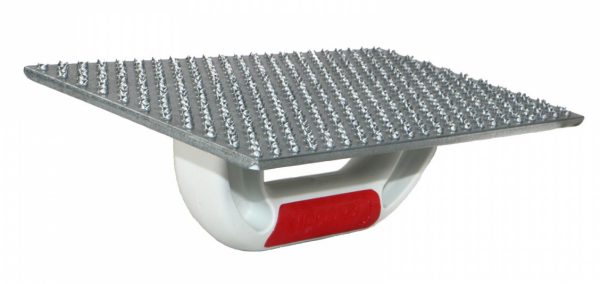
Plastic
Such graters are used for high-quality application of building mixtures: putties, plasters, decorative materials, adhesives. They distribute the mass well over the surface, smooth out seams and irregularities, while being suitable for the formation of bark beetle coatings. Nevertheless, the service life of plastic graters is small, so they are often chosen for one-time work. Also, they are not suitable for applying a thick layer of plaster.
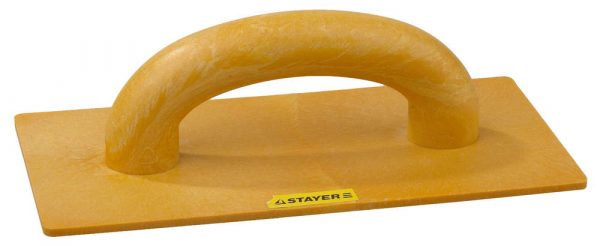
Sponge graters and graters
Sponge tools are made of foam sponge, latex or rubber. They are used for processing structural plaster, grouting other decorative materials. Typically, the body of the graters is made of lightweight aluminum or polyurethane, and the sponge itself is located only on the grinding sole. Such tools allow you to create drawings on the plaster and can not be used to seal the mortar, giving perfect smoothness or gloss.
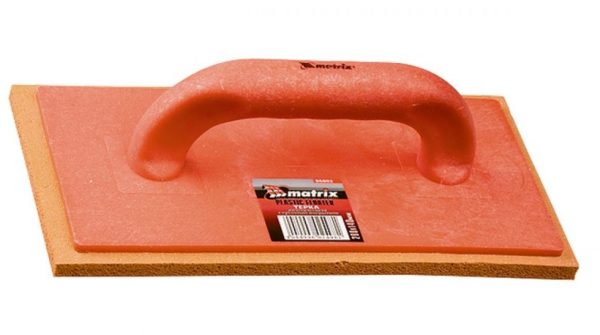
Grater or grater: what is the difference
A grater is called a grater, which is narrower and longer than ordinary. The stucco grater has another name - trowel. Most often, it is not used to completely mash the plaster, but to remove flaws from the already applied layer, smooth small areas, remove excess solution. If you want to give the wall smoothness, you can’t cope with such a task with just a single grater, you need a regular grater.

Better to use
The choice of tool depends on the specific task facing the finisher, on the level of his skill and knowledge of plastering supplies. The most successful option among professionals is considered to be a grater: it allows you to perform most of the work on applying, rubbing and grinding walls, which can not be said about the trowel. Most often, experts choose polyurethane graters that can be used for a long time and carry out a wide range of tasks for facing different surfaces.
to contents ↑
Advantages and disadvantages of various stucco graters
Each tool has its pros and cons, so the choice always remains with the master:
| Variety of graters | Advantages | disadvantages |
|---|---|---|
| Wooden | Low price, lightness, compactness | Rapid moisture impregnation, deformation, abrasion, short life, rapid loss of quality |
| Foam | Cheapness, the ability to perfectly smooth fine-grained plasters | Fragility, especially in terms of the handle, the need for experience to work with such a tool |
| Polyurethane | No need for experience, lightness, ergonomics, low abrasion, optimal softness, elimination of deformation over time, suitability for almost all types of work, including for their large volume | High price for products made of the highest quality polyurethane (standard graters are inexpensive) |
| Plastic | Resistance to corrosion, durability, ease of holding in the hand, lightness | Lack of flexibility, fragility at temperature extremes, use only for a small amount of work, unsuitable for beginners |
| Spongy | Ability to work with decorative plaster and create interesting effects, lightness, ergonomics | Uselessness for mashing to perfect smoothness, glossy, the risk of tearing the spongy sole from the base with careless use |
| Metal | Application for compacting and ironing plaster, for leveling porous mortars, strength, smoothness, smoothing joints | Unsuitability for classical leveling and mashing of mortar, for decorative plasters, high cost, tendency to corrosion (we are talking about graters made of simple carbon steel) |
Tool selection
Before buying, you should carefully examine the device and make sure that it suits the master in all respects:
- it’s convenient to hold a good tool in your hand, it has a comfortable handle in which there are recesses for the fingers;
- on the working canvas there should be no potholes, other defects that can scratch the coating, the performance material must be of the highest quality;
- for a large volume, choose a larger product, otherwise mashing or applying plaster will be too slow; compact graters are well suited for small areas, but, in any case, you should correlate the dimensions of the tool with your own palm;
- a short tool is suitable for walls with artificially created openings, and a long tool for open areas;
- you can not confuse polystyrene products with polyurethane - these are two different materials, which have their pros and cons;
- to prepare the surface for painting, especially with light paints, it is worth choosing metal devices;
- in skillful hands, a spongy polterok can replace a textured roller, but this requires some experience;
- cracked wooden fixtures with cracks may be suitable for applying bark beetle plasters.
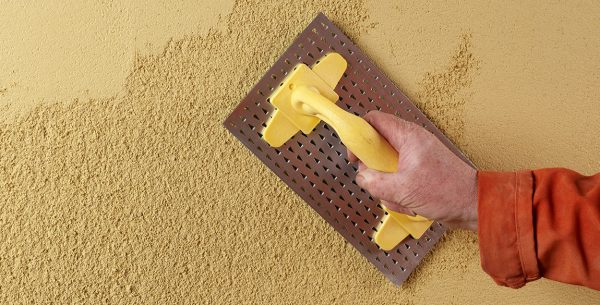
Features of the use of graters and half-graters
Such tools are used to mash the walls after applying the finishing layer of plaster (covering). Movements must be carried out smoothly, with uniform pressure, "drawing" circles counterclockwise. Also, experts use other types of movements: up and down, in the form of a figure eight. Typically, wall treatment is carried out sequentially in small sections. After giving smoothness to the first section, they move on to the next.
You need to work on dried plaster, periodically wetting the sole of the tool with water. You can even distribute a crude solution to the base with a grater, using it instead of a spatula. To work with decorative plasters such as bark beetles, other methods are used: they stretch the solution along the surface, getting small grooves. To create a spiral texture, make the appropriate movements with a plastic or sponge grater. The picture will fully appear only after the wall dries. Further, individual seams, irregularities are polished with a trowel.
to contents ↑
Top manufacturers
High-quality trowels and other trowel tools are produced by FIT, Hobbi, SibrTech, Zubr, PU-TECH, DEXX, Stayer and others. Examples of quality models are:
- FIT IT 05301 (280 x 140 x 90 mm) - the sole has a sponge made of foam rubber material; it is used to fine-tune the finishing layer of plaster;
- MATRIX 86802 - polypropylene tool with a hard sponge on the sole, size - 140 x 280 cm;
- “Oleinik” plaster cast iron - a stainless steel product with a wooden handle, suitable for all smooth plasters;
- sponge grater "Volma" on a telescopic rod - easy to use thanks to a long adjustable handle.
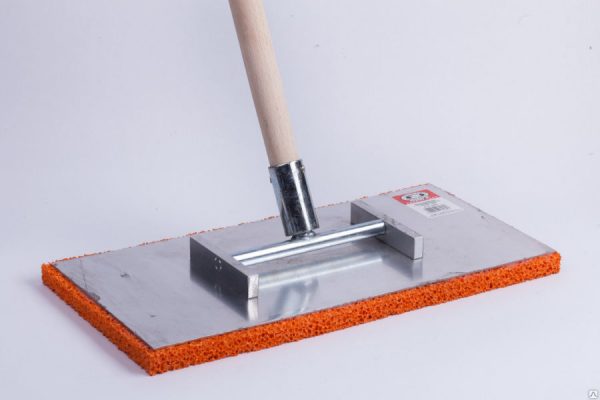
Despite the length and complexity of plastering, using high-quality tools can seriously simplify the task. A responsible attitude to the choice of a construction grater and the correctness of its use will help to obtain an excellent result: perfectly smooth and beautiful walls.



